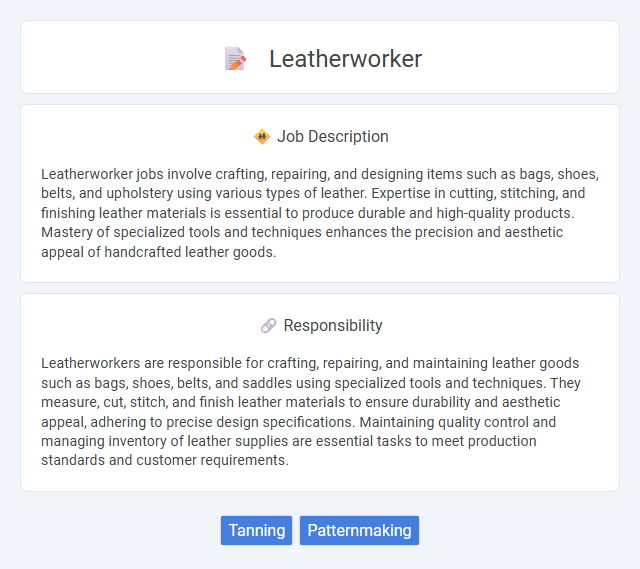
Leatherworker jobs involve crafting, repairing, and designing items such as bags, shoes, belts, and upholstery using various types of leather. Expertise in cutting, stitching, and finishing leather materials is essential to produce durable and high-quality products. Mastery of specialized tools and techniques enhances the precision and aesthetic appeal of handcrafted leather goods.
Individuals with strong attention to detail and patience are likely to be well-suited for a leatherworker job due to the precision required in crafting and stitching leather goods. Those who enjoy hands-on, creative tasks and have good manual dexterity probably find satisfaction in this occupation. People with sensitivity to repetitive motions or poor hand-eye coordination may experience challenges in performing effectively in this role.
Qualification
Leatherworkers require specialized skills in cutting, shaping, and stitching leather to create durable goods such as bags, shoes, and belts. Proficiency in using hand tools, sewing machines, and an understanding of different leather types ensures high-quality craftsmanship. Formal training through apprenticeships or vocational programs enhances precision, while knowledge of safety protocols and design principles is essential for a successful career.
Responsibility
Leatherworkers are responsible for crafting, repairing, and maintaining leather goods such as bags, shoes, belts, and saddles using specialized tools and techniques. They measure, cut, stitch, and finish leather materials to ensure durability and aesthetic appeal, adhering to precise design specifications. Maintaining quality control and managing inventory of leather supplies are essential tasks to meet production standards and customer requirements.
Benefit
Leatherworking jobs likely offer the benefit of developing highly specialized craftsmanship skills that can lead to increased job satisfaction and marketability. Working with quality materials, leatherworkers probably enjoy creating durable, custom products that may appeal to niche markets, potentially enhancing income stability. The role may also provide opportunities for creative expression and entrepreneurship, contributing to personal and professional growth.
Challenge
Leatherworking may present significant challenges due to the precision required in cutting, stitching, and molding materials to create high-quality products. The probability of encountering difficulties increases with complex designs and the need for durability in finished goods. Mastery of various tools and techniques is likely necessary to overcome these obstacles and achieve professional results.
Career Advancement
Leatherworker career advancement often involves gaining specialized skills in crafting high-quality leather goods, leading to opportunities as master artisans or workshop supervisors. Progression can include roles such as product designers or quality control managers within fashion and luxury brands. Continuous skill development in techniques like tooling, stitching, and pattern making enhances prospects for entrepreneurship or higher-level positions in the leather industry.
Key Terms
Tanning
Leatherworkers specializing in tanning transform raw hides into durable leather using chemical, vegetable, or chrome tanning methods. The tanning process stabilizes collagen fibers, enhancing leather's water resistance, flexibility, and longevity. Mastery of drying, conditioning, and finishing techniques ensures high-quality leather suited for fashion, upholstery, and industrial applications.
Patternmaking
Leatherworkers specializing in patternmaking create precise templates that guide the cutting and assembly of leather goods, ensuring accurate dimensions and consistent quality. Mastery in patternmaking involves understanding leather behavior and optimizing material usage to minimize waste. Advanced skills in CAD software and traditional hand-drafting techniques are essential to develop durable, functional, and aesthetically pleasing patterns for items like bags, shoes, and belts.
 kuljobs.com
kuljobs.com